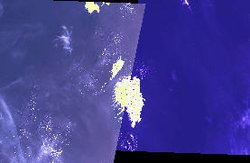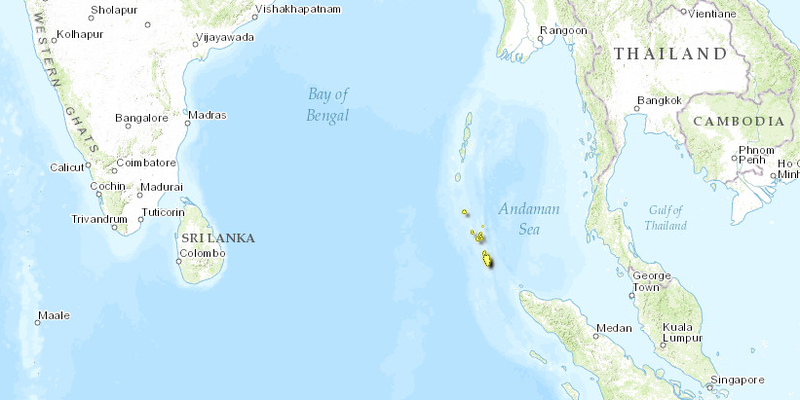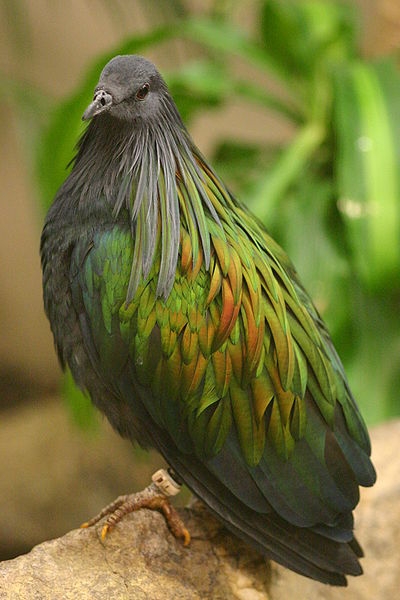Nicobar Islands rain forests
Introduction The isolation of the Nicobar Islands Rain Forests has given rise to endemic plant and animal species. The rain forests are in good shape and are afforded a high level of protection, but the future biodiversity (Nicobar Islands rain forests) of the ecoregion is not yet secure.
Location and General Description
 Satellite view of Great Nicobar Island, India. (Source: Photograph by USGS)
Satellite view of Great Nicobar Island, India. (Source: Photograph by USGS) The Nicobar Islands consist of twenty-two islands of varying size and are located in the eastern Indian Ocean as part of the Bay of Bengal. The Nicobars are separated from the Andamans in the north by a 150-kilometer (km)-wide channel and are 189 km from Sumatra to the southeast. The climate of the Nicobar Islands is warm tropical, with temperatures ranging from 22 to 30 °C and 3,000-3,800 millimeter (mm) annual average rainfall. Rainfall is heavily influenced by monsoons, which come from the southwest (May to September) and the northeast (October to December). The only perennial rivers are found on Great Nicobar.
 WWF The islands are geologically part of long island arch that runs from Arakan Yoma in Myanmar to the Mentawai Islands off Sumatra and include the Andamans and many underwater sea mounts. The arch was formed as the uplift along the subduction of the Indian-Australian plate in the late Eocene or early Oligocene. Isolation of the Nicobars from the mainland resulted from the opening of the Andaman Sea in the middle Miocene about 10.8 million years ago (mya). Unlike the Andamans, which are thought to have been connected to mainland Myanmar during periods of falling sea levels of the Pleistocene, the Nicobars remained as islands. Falling sea levels during this time joined many of the islands into three distinct groups, each of which has its own biological character today: Great Nicobar in the south (including Great Nicobar, Little Nicobar, Meroe, and satellites), Nancowry and the middle Nicobars (Nancowry, Katchall, Camorta, Teressa Chaura, and Tillanchong), and Car Nicobar to the north (including Car Nicobar and Batti Malv). The highest point in the Nicobars is Mt. Thullier, at 670 meters (m). The higher elevations of the Nicobars often contain serpentine and gabbro formations, whereas at lower elevations Eocene sediments (sandstones, shales, and siltstones) with ultrabasic igneous intrusions predominate. Great Nicobar contains younger substrates from the Tertiary that are more like the soils of parts of Sumatra than the other islands.
WWF The islands are geologically part of long island arch that runs from Arakan Yoma in Myanmar to the Mentawai Islands off Sumatra and include the Andamans and many underwater sea mounts. The arch was formed as the uplift along the subduction of the Indian-Australian plate in the late Eocene or early Oligocene. Isolation of the Nicobars from the mainland resulted from the opening of the Andaman Sea in the middle Miocene about 10.8 million years ago (mya). Unlike the Andamans, which are thought to have been connected to mainland Myanmar during periods of falling sea levels of the Pleistocene, the Nicobars remained as islands. Falling sea levels during this time joined many of the islands into three distinct groups, each of which has its own biological character today: Great Nicobar in the south (including Great Nicobar, Little Nicobar, Meroe, and satellites), Nancowry and the middle Nicobars (Nancowry, Katchall, Camorta, Teressa Chaura, and Tillanchong), and Car Nicobar to the north (including Car Nicobar and Batti Malv). The highest point in the Nicobars is Mt. Thullier, at 670 meters (m). The higher elevations of the Nicobars often contain serpentine and gabbro formations, whereas at lower elevations Eocene sediments (sandstones, shales, and siltstones) with ultrabasic igneous intrusions predominate. Great Nicobar contains younger substrates from the Tertiary that are more like the soils of parts of Sumatra than the other islands.
The vegetation of the Nicobars typically is divided into the coastal and mangrove forests and the interior evergreen and deciduous forests. Additionally, Kamorta, Katchall, Nancowry, and Car Nicobar all contain extensive interior grasslands, but these are thought to be anthropogenic in origin. The grasslands are composed mainly of Imperata cylindrica, Saccharum spontaneum, Heteropogon contortus, Chloris barbata, Chrysopogon aciculatus, and Scleria cochinchinensis, along with many herbs and shrubs. Evergreen forests of Great Nicobar, Kamorta, and Katchall are dominated by Calophyllum soulattri, Sideroxylon longipetiolatum, Garcinia xanthochymus, Pisonia excelsa, and Mangifera sylvatica. Other important species of Kamorta and Katchall are Artocarpus peduncularis, Radermachera lobbi, Symplocos leiostachya, and Bentinckia nicobarica. Deciduous forests occur at lower elevations on Great Nicobar and include Terminalia procera and T. bialata.
Biodiversity Features
|
Table 1. Endemic and Near-Endemic Mammal Species. Family Species Sorcidae Crocidura nicobarica* Tupaiidae Tupaia nicobarica* Pteropodidae Pteropus faunulus* Muridae Rattus palmarum* *An asterisk signifies that the species' range is limited to this ecoregio The isolation of the Nicobars has given rise to a number of endemic plant and animal species. The Nicobar Islands Rain Forests contain twenty-five native mammal species, four of which are strict endemics (Table 1). The majority of species are bats, and rodents (all rats) are the second most numerous order. Several larger species exist, however, including wild pig (Sus scrofa) and Nicobar macaque (Macaca fascicularis umbra). There is also a unique tree-shrew (Tupaia nicobarica), which is the most arboreal member of its genus. All four endemics in Table 1 are considered threatened by IUCN (Nicobar Islands rain forests) (categories VU and above). There are eighty-two native, nonpelagic bird species in the Nicobars, and nine of them are endemic (Table 2). The list of endemics matches the list of nine restricted-range species from BirdLife International's Nicobar Islands Endemic Bird Area (EBA). There are also many species and subspecies shared only with the Andamans. Two of the endemics are threatened (VU or above) (Megapodius nicobariensis, Hypsipetes nicobariensis).
| ||||||||
